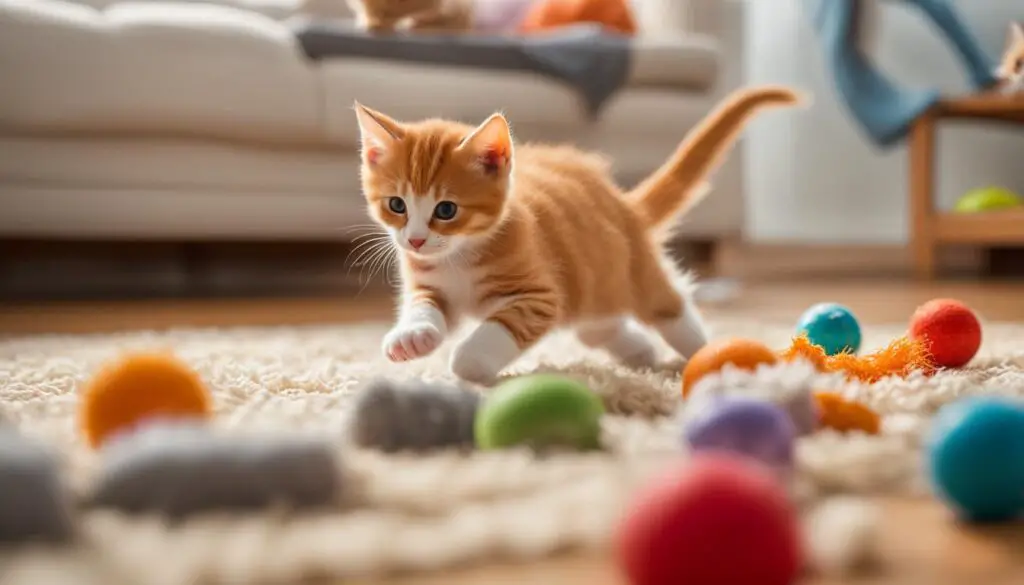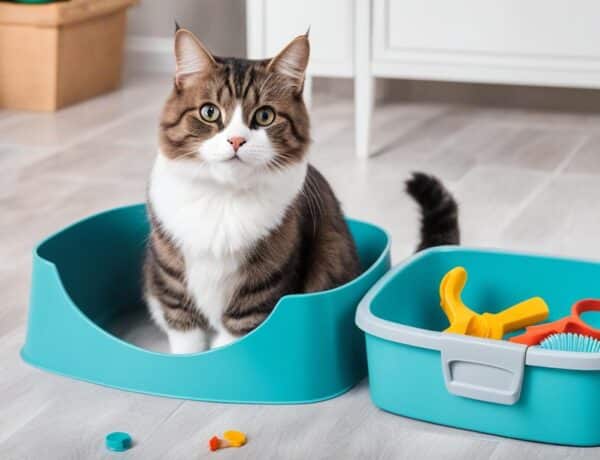Welcome to the beginner’s guide on socializing your new kitten! In this guide, I will provide you with valuable tips and techniques to help your adorable feline friend become a well-adjusted and loving pet. Socialization plays a crucial role in shaping your kitten’s behavior and ensuring their overall happiness.
When bringing a new kitten into your home, it’s important to remember that they may feel overwhelmed in their new environment. By following the steps outlined in this guide, you’ll be able to create a safe and comfortable space for your kitten to thrive. So let’s dive in and discover the secrets to successful kitten socialization!
Key Takeaways
- Socializing your new kitten is essential for their well-being and development.
- Creating a safe and comfortable environment will help your kitten feel secure.
- Using food and play as tools can strengthen the bond between you and your kitten.
- Introducing your kitten to new experiences and faces will help them become comfortable around different people and pets.
- Keeping your kitten safe requires taking precautions and removing potential hazards from their surroundings.
Socialization Tips for Older Kittens
Socializing older kittens, especially feral kittens over 4 months of age, can be quite challenging. However, with the right approach, it is not impossible to help these kittens become more comfortable with humans and adapt to a domestic environment. The socialization process for older kittens is slightly different from that of younger ones, and it requires time, patience, and consistent one-on-one interaction.
Before embarking on the socialization journey, it is crucial to assess the personality and social behavior of each individual kitten. Some older kittens may already exhibit signs of social behavior, making them more trainable and suitable for socialization. These kittens have a higher likelihood of progressing well in a foster home and eventually being adopted into a loving family.
When fostering older kittens, it is recommended to dedicate at least a couple of hours each day for one-on-one interaction. This allows you to build trust, establish a positive relationship, and help the kittens become comfortable with human touch and presence. Consistency is key, so maintaining a regular schedule and providing a calm and quiet environment will aid in the socialization process.
In some cases, despite consistent efforts, older kittens may show limited progress in their socialization. If there is no noticeable improvement within a week, it is best to consider alternatives such as a Trap-Neuter-Return (TNR) program. Returning the kitten to their outdoor colony, where they are familiar and comfortable, can help prevent ongoing stress and ensure their overall well-being.
Socialization Tips for Older Kittens
| Tips | Description |
|---|---|
| Assess individual kitten’s personality | Evaluate the social behavior and trainability of each older kitten before starting the socialization process. |
| Provide one-on-one interaction | Dedicate at least a couple of hours daily for bonding and socialization with the older kittens. |
| Establish a regular schedule | Maintain consistency by following a regular socialization routine, creating a sense of security and familiarity. |
| Consider alternative options | If older kittens show limited progress within a week, explore alternative solutions like a Trap-Neuter-Return (TNR) program. |
Remember, socializing older kittens requires patience, understanding, and adaptability. Every kitten is unique, and their progress will vary. By providing a nurturing and supportive environment, you can help older kittens transition from their feral beginnings to becoming beloved pets in forever homes.
Helping Kittens Feel Comfortable
Creating a comfortable and safe environment is crucial for helping kittens adjust to their new surroundings and ensuring their successful socialization. Here are some tips to make kittens feel comfortable:
- Set up a crate at an elevated position: Providing a crate or a cozy spot at an elevated position allows kittens to observe their surroundings and feel secure. This gives them a sense of control and helps ease their anxiety.
- Provide an adjustment period: Give kittens at least two days to acclimate to their new environment before engaging in extensive interaction. This allows them to explore and familiarize themselves with their surroundings at their own pace.
- Use soothing techniques: Create a soothing atmosphere by placing a ticking clock near the kittens’ sleeping area. The rhythmic sound mimics their mother’s heartbeat and can help calm and reassure them.
- Gradually introduce new sights and sounds: Help kittens adapt to new stimuli by leaving a TV or radio on at a low volume. This exposure gradually exposes them to different sounds, making them more comfortable with the noises of their future daily life.
- Reward positive behavior: Encourage desirable behavior in kittens by providing treats or praise when they display socialization progress or engage in appropriate interactions. Positive reinforcement helps kittens associate socializing with positive experiences.
- Separate slow-to-socialize kittens: If some kittens are slower to adapt to socialization, consider separating them temporarily for more focused one-on-one interaction. This individual attention can help build their confidence and progress at their own pace.
“Spitting, hissing, and hiding are signs of fear, not aggression. Be patient and avoid scolding or punishing kittens for displaying these behaviors.”
Remember, it’s important to be patient when helping kittens feel comfortable. Each kitten is unique and may require different amounts of time and support. By creating a safe and nurturing environment, you can help kittens adjust and thrive in their new surroundings.
Socializing With Food
Food can be a powerful tool for socializing kittens. By giving them treats and associating them with your presence, you can help them develop positive associations and build trust. Here are some tips on how to socialize kittens with food:
- Leave dry kitten food out all day: Having access to food throughout the day allows kittens to feel more comfortable in their surroundings.
- Sit in the room while feeding wet food: When feeding kittens wet food, make sure to be present in the room. This will help them associate your presence with a positive experience.
- Pet and hold kittens while they eat: While the kittens are eating, gently pet and hold them to reinforce positive experiences and create a bond.
- Avoid finger-feeding: While it may be tempting to feed kittens with your fingers, it’s important to avoid this practice. Finger-feeding can lead to biting and scratching habits that are difficult to break.
- Use wet food or baby food as rewards: Wet food or baby food can be used as special treats or rewards during socialization. However, make sure they do not contain onion, as it is toxic to cats.
By incorporating these techniques into your kitten’s feeding routine, you can help them feel more comfortable and build positive associations with you and their environment.
Socializing With Play
Playtime is an essential part of socializing kittens and building trust. Spending quality time engaging in play with your kitten not only provides them with physical exercise but also strengthens the bond between you and your furry friend. By using playtime as a tool for socialization, you can create a positive and enjoyable environment for your kitten to grow and thrive.
During play sessions, it’s important to focus on individual interactions with each kitten. Dedicate at least two hours a day to playing with each kitten separately, using toys and interactive play to engage them. This one-on-one time allows you to build a connection and establish trust with your kitten.
When playing with your kitten, hold them close to your body to make them feel secure. This physical contact helps them feel safe and nurtured. As the kittens grow older, encourage independent play by introducing toys that stimulate their natural instincts, such as toys that resemble prey or objects they can chase and pounce on.
To give you a better idea of how playtime can aid in socialization, here’s an example of a playtime routine:
Playtime Routine:
- Start by creating a safe and kitten-proof play area. Remove any hazardous items and ensure the space is free from potential dangers.
- Choose a variety of toys that engage your kitten’s senses, such as feather wands, crinkle balls, or interactive puzzle toys. Having a diverse selection of toys can keep their interest and prevent boredom.
- Begin the play session by stimulating your kitten’s natural hunting instincts. Use a toy that mimics the movement of prey, such as a feather wand, and gently move it around, encouraging your kitten to chase and pounce.
- Allow your kitten to catch the toy occasionally to boost their confidence and provide a sense of accomplishment.
- As playtime progresses, introduce more interactive and mentally stimulating activities, such as puzzle toys that dispense treats. This helps keep them mentally engaged and rewards them for their curiosity and problem-solving skills.
- Always end the play session on a positive note. Gradually wind down the play by reducing the intensity of the movements and allowing your kitten to relax.
By consistently incorporating playtime into your daily routine, you provide your kitten with a positive, engaging, and interactive experience. This not only helps them develop essential social skills but also ensures they remain mentally and physically stimulated. Remember, playtime is not just about entertainment—it’s a valuable opportunity to socialize and build a strong and trusting relationship with your kitten.
Introduce New Friends
When bringing a new kitten into your home, it is important to introduce them to other pets and help them socialize with different animals. This process is crucial to ensure that your kitten feels comfortable and confident around all people and pets.
Introducing Kittens to Grown-Up Cats
If all animals involved are healthy and up-to-date on vaccinations, you can gradually introduce your new kittens to grown-up cats under close supervision. This introduction should be done in a controlled environment, such as a neutral room. By taking these precautions, you can monitor their interactions and intervene if necessary.
“Introducing kittens to grown-up cats should be done gradually and under supervision to ensure a positive social experience.”
– Dr. Jane Smith, Feline Behavior Expert
One effective way to introduce kittens to grown-up cats is by using a neutered tom cat as a role model. Tom cats often exhibit playful and gentle behavior, which can create a positive social experience for the kittens. This interaction allows the kittens to learn proper feline etiquette and grooming techniques from an experienced cat.
Handling Frightened Kittens
It is common for kittens to feel fearful or anxious during the introduction process. When dealing with frightened kittens, it is important to take additional precautions and ensure their safety. Always wear protective clothing, such as long sleeves and gloves, to avoid scratches or bites.
Scruffing can be used as a technique to gain control of frightened kittens. However, it is essential to perform this action gently and provide support for their hind legs. This ensures that the kitten feels secure and prevents any discomfort or injury.
Building Positive Experiences
Creating positive experiences during introductions is crucial for socializing kittens with other animals. Encourage calm and gentle interactions, and reward both the kittens and existing pets for good behavior during these sessions. Over time, this positive reinforcement will help the kittens associate pleasant experiences with the presence of other animals.
To summarize, introducing kittens to other pets is an important step in their socialization process. By following appropriate measures, like supervising introductions, using role model cats, and handling frightened kittens with care, you can foster positive relationships and help your new furry friends feel comfortable around other animals.
| Benefits of Introducing Kittens to Other Pets | Tips for a Successful Introduction |
|---|---|
| 1. Helps kittens develop social skills | 1. Choose a neutral space for introductions |
| 2. Promotes positive interactions with other animals | 2. Monitor the initial interactions closely |
| 3. Provides companionship for the kittens | 3. Gradually increase the duration of interactions |
| 4. Reduces the chances of future aggression | 4. Reward good behavior during introductions |
Precautions for Keeping Kittens Safe
To ensure the safety and well-being of your adorable kittens, it’s essential to take certain precautions and kitten-proof your home. By eliminating potential hazards and creating a secure environment, you can provide a safe space for your furry friends to explore and play.
Avoid Toxic Cleaning Products
When it comes to cleaning the areas where your kittens roam, it’s crucial to steer clear of toxic cleaning products. Many household cleaners contain chemicals that can be harmful or even fatal to kittens if ingested or inhaled. Instead, opt for pet-safe, non-toxic cleaning alternatives and natural cleaners to maintain a clean and safe environment.
Remove Potential Hazards
Take a careful look around the room where your kittens spend most of their time and remove any potential hazards that could harm them. Keep in mind that kittens are naturally curious and have a knack for getting themselves into tricky situations. Be especially mindful of small objects, electrical cords, toxic plants, and household chemicals that they may encounter. By eliminating these dangers, you can minimize the risk of accidents and keep your kittens safe.
Double Check Windows and Vents
Kittens are known for their agility and ability to squeeze into small spaces. To prevent any accidental escapes or injuries, ensure that all windows are securely closed and that vents are covered with appropriate mesh to prevent kittens from crawling through. It’s better to be safe than sorry when it comes to kitten-proofing your home.
Handle Kittens with Caution
When handling kittens, it’s crucial to exercise caution and be gentle with them. Avoid excessive squeezing or rough handling, as kittens are delicate creatures. If you need to gain control of a frightened or unruly kitten, use a gentle scruffing technique, supporting their hind legs to minimize stress. Remember, the goal is to create a calm and safe environment for your kittens to thrive.
Diluted Bleach Solutions for Cleanups
Accidents happen, and occasional cleanups may be necessary, especially during the early stages of kittenhood. If you need to clean an area with potential pathogens, diluted bleach solutions can be used. However, it’s crucial to use them in small amounts and ensure that your kittens are not exposed to the fumes or residue. Always follow instructions carefully and provide adequate ventilation.
Remember, the safety and well-being of your kittens should always be a top priority. By taking these precautions and kitten-proofing your home, you can create a safe and secure environment for your furry friends to live, explore, and play.
Conclusion
Socializing a new kitten at home requires time, patience, and understanding. By following the tips and techniques provided in this guide, you can help your new furry friend feel comfortable and confident in their new environment. From providing a safe space to using food and play as tools for socialization, each step plays a crucial role in building a strong bond between you and your kitten.
Remember to be patient with your kitten’s progress and reward positive behavior. Every kitten is unique and may require different amounts of time and effort to socialize effectively. If you encounter any challenges or require professional advice, don’t hesitate to seek assistance from a qualified veterinarian or animal behaviorist.
With proper socialization, your new kitten will have the opportunity to grow up to be a loving and well-adjusted pet, bringing joy and companionship to your home for years to come. Enjoy the journey of building a strong bond with your new feline friend and treasure the moments of shared play, love, and affection.
FAQ
How important is socializing a new kitten?
Socializing a new kitten is crucial for their development as a loving and well-adjusted pet.
Can older kittens be socialized?
Yes, older kittens, including feral kittens over 4 months of age, can be socialized with time and patience.
What should I do if an older kitten is not progressing in socialization?
If there is no progress within a week, it is best to return the kitten to their outdoor colony through Trap-Neuter-Return (TNR) to avoid ongoing stress.
How can I create a comfortable environment for my kitten?
Set up a crate at an elevated position, provide an adjustment period, and use soothing techniques like a ticking clock to remind them of their mother’s heartbeat.
How can I use food to socialize kittens?
Giving treats and associating them with your presence can help kittens develop positive associations. Leaving dry kitten food out all day and sitting in the room while feeding them wet food can build trust.
How can playtime help with kitten socialization?
Spending at least two hours a day playing with each kitten individually using toys and interactive play can help build trust and socialize kittens.
Can kittens be introduced to other pets?
Yes, if all animals are healthy, kittens can be introduced to grown-up cats under supervision, allowing for playful interaction and grooming experiences.
What precautions should I take to keep kittens safe?
Remove potential hazards from the room, such as toxic cleaning products, knick-knacks, and ensure windows and vents are secure to prevent escapes.
How can I socialize a new kitten at home?
By following the tips and techniques provided in this guide, you can help your new kitten feel comfortable and confident in their new environment, leading to a loving and well-adjusted pet.







No Comments